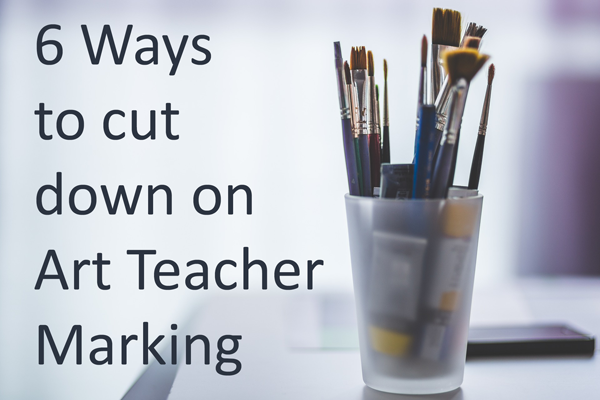Is it really possible to cut down on marking? With a little forethought and planning the answer is most definitely yes. The following are 6 strategies I use all the time which keep me on top of my marking workload whilst still supporting and moving students forward.
1 – A Double Page Spread With Several Pieces of Work On It
This sounds so simple but can make the difference between several pieces of work to mark, or one. Below is a good example. You can see the students photographs on the left and three pieces of work inspired by these on the right. The photographs were homework and the 3 pieces of work took many lessons to complete and only required one lot of marking. Different schools have different marking policies and many schools require teachers to mark every page. This is one great way to cut down on marking.


The project above is called ‘Chirascuro by Antonia‘ and you can see more by following the link.
2. Homework Worksheets
It’s a similar story with homework. I have lots of detailed worksheets where each page has several tasks on it, which, if done well, take a long time. I set a task each week for several weeks and when it’s complete, it only takes one lot of marking. Genius! There are some good examples below which are available on with website. The ‘Drawing Close-Ups of Fruit’ required students to complete 8 small drawings. These could be completed over several weeks. You can get your students to work with different media too. Likewise with the chocolate packaging. This could be one lot of marking for many homework tasks!
3. Breaking Down Tasks
Another way to reduce the amount of marking you do, and to accomplish great results, is to break down homework into separate tasks. For example, I often ask students to create a research page on an artist. The first homework I set is likely to be to create a title which may be by hand or using an App, depending on who the artist is. The second homework would be to collect facts about the artists, and the third and final homework would be to collect images of the artist’s work and put the page together. Having given them 3 homework slots to complete this task I would have high expectations about its quality.
4. Peer & Self Assessment
Peer and & Self Assessment are your friend! If you give lesson time over to getting your class to peer or self-assess their work properly, it is perfectly fine for you not to write a comment on that page and just put a grade in your mark book. Writing a comment for improvement is often the time-consuming element of marking. If this has been accomplished through peer or self-assessment you’re off the hook. Below are some peer and self-assessment resources available on The Arty Teacher. Click on an image to learn more.
5. Verbal Feedback
I’m not a fan of stamping work with ‘Verbal Feedback Given’ as I’m certain that if I asked a majority of children a few weeks later what that feedback had been, they wouldn’t remember. Who benefits from that? Verbal feedback is more effective if you speak one-to-one with the student and then give them one clear target of what they should do next. You may wish to get them to repeat what it is that you want them to do. If you feel that you must evidence that VF has taken place, ask them to write the target in their sketchbook or on the back of their work. There is an interesting (and damning) article about Verbal Feedback Stamps by TeachToolkit here.
6. Homeworks that Don’t Need Marking
If you are a regular visitor to The Arty Teacher who will have already seen my ‘Art Homework That Doesn’t Need Marking’ free resource. It’s been downloaded over 1000 times!!! I only believe in setting quality homework – after all, art seems to be squeezed out of curriculum far too often, we need every chance we can get to get children doing art. Hopefully, some of these tasks would fit in with what you are teaching and provide further opportunities for learning. Click the image below to learn more.

If you plan pages with several pieces of work on (which often look better than one drawing plonked in the middle of a page) for both homework and classwork, if you build in peer and self-assessment into the projects you teach, and occasionally set a homework that doesn’t need marking, you will, without a doubt, have less to mark.
7. ***New*** Stickers to Save Time When Marking!!
I’m so excited about using these stickers this year as I know they are going to save me so much time. This download includes the 7 most frequent things art teachers write when marking a drawing. I lay out all the work, group them into piles that need the same comment to improve and then pop on a sticker. Of course, you are going to need to write the odd one out by hand that doesn’t fit into one of these 7 comments, but you’ll find a majority do. What a time-saver!

Please comment below if you have useful strategies to share.








Leave a Reply